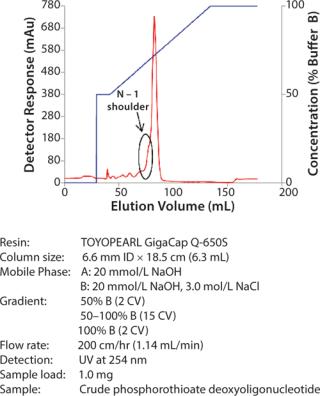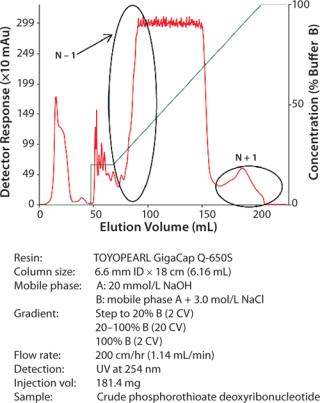TOYOPEARL GigaCap Q-650S high capacity, high resolution anion-exchange resin for process scale applications was recently introduced by Tosoh Corporation. This resin, with dynamic binding capacities (DBCs) approaching 190 g/L for bovine serum albumin (BSA), is the newest member of the TOYOPEARL® product line.
TOYOPEARL GigaCap Q-650S maintains the high capacity of our popular TOYOPEARL GigaCap Q-650M, and the 35 µm particle size provides high resolution for improved separation of process impurities and aggregates.
IntroductionThe purification of oligonucleotides using anion exchange chromatography has traditionally fallen to resins such as TSKgel® SuperQ-5PW (20) that offer high resolution and selectivity in conjunction with excellent mechanical stability at very high column pressures. TOYOPEARL GigaCap Q-650S resin offers a low pressure alternative to oligonucleotide purification while preserving the selectivity, resolution, and yields of those higher pressure processes.
TOYOPEARL and TSKgel products are hydroxylated methacrylic polymer resins made commercially in many different pore sizes and particle diameters. TOYOPEARL resins vary from TSKgel resins by having a lower degree of crosslinking. Lower crosslinking makes available a larger number of resin sites for ligand immobilization when producing TOYOPEARL resins. This lower degree of crosslinking also makes for a less rigid bead. Therefore a functionalized TOYOPEARL resin will have a lower pressure rating than the corresponding TSKgel material.
Because similarly functionalized TSKgel and TOYOPEARL resin types have the same backbone polymer chemistry, the selectivity for proteins, oligonucleotides, and their attendant impurities remains the same. TOYOPEARL resin products can be used at high linear velocities and withstand operating pressures up to 0.3 MPa, while TSKgel resins can withstand operating pressures of up to 2.0 MPa.
Table 1 shows the properties and DBC for the oligonucleotide used in these experiments of TOYOPEARL GigaCap Q-650S. The following experiments detail the purification of an oligonucleotide by TOYOPEARL GigaCap Q-650S resin.
Table 1:Oligonucleotides are short, linear sequences of deoxyribonucleic acid (DNA) or ribonucleic acid (RNA) that are generally manufactured using chemical synthesis. Because of the unique structure of these molecules and the way they are synthesized, oligonucleotides require special considerations during chromatographic purification.
During synthesis of an oligonucleotide, there are a small percentage of sequences in which a segment may either be deleted or may have more than one segment attached (N – 1 and N + 1, respectively, are the common nomenclature). Taken collectively, these synthesis errors may produce measurable amounts of impurities. The similarity in the impurities to the target molecule requires a high resolution technique to adequately isolate the target molecule.
Experimental Conditions and ResultsThe data presented here demonstrate the capability of TOYOPEARL GigaCap Q-650S resin to purify a phosphorothioate deoxyribonucleotide (24-mer).
Experiments were carried out on a 6.6 mm ID × 18.0 cm column packed with TOYOPEARL GigaCap Q-650S. The column was first under-loaded with a 1.0 mg sample of crude oligonucleotide to better visualize resin performance (Figure 1). As can be seen from this chromatogram, the N – 1 peak was resolved as a shoulder to the main oligonucleotide peak. HPLC analysis of fractions taken across the peaks (data not shown) revealed that this resin was able to adequately resolve the full length oligonucleotide.
After optimizing the elution gradient, the performance of the resin was then tested at 80% of its DBC for this oligonucleotide (Figure 2). As can be seen in the chromatogram, there was a visible N + 1 peak resolved from the largest oligonucleotide peak in addition to the N – 1 peak. Many of the low–molecular-weight impurities are visually resolved as well. Though the chromatogram in Figure 2 went off scale for ultraviolet (UV) detection, the general shape of the chromatogram was unchanged from that of the corresponding chromatogram when only 1.0 mg was loaded. HPLC analysis of fraction purity (data not shown) indicates that selectivity and resolution are maintained even at 80% DBC loading conditions.
An enlarged image of the main oligonucleotide peak (overlaid with a histogram showing HPLC results for fraction purity) highlights the chromatographic separation of the full length oligonucleotide (Figure 3). At 80% DBC, the TOYOPEARL Q-650S was still able to maintain resolution and selectivity.
After pooling fractions of purified oligonucleotide, the yield and purity of the final product was determined (Table 2). Yield was determined by comparing the amount of full length oligonucleotide present in the crude sample loaded onto the column with the amount of full length oligonucleotide present in the fraction po
ol.
The TOYOPEARL GigaCap Q-650S generated very high purity, full length oligonucleotide (96.9%) from crude synthesis material. The yield of full length oligonucleotide was also very good at 81.3%.
ConclusionsTOYOPEARL GigaCap Q-650S is capable of delivering oligonucleotides of very high purity and at high process yields at lower pressures than those used with the TSKgel SuperQ-5PW (20) resin. This capability allows chromatographers to purify oligonucleotides without the added expense of purchasing high pressure manufacturing equipment.
More information on the purification of oligonucleotides can be found on the Tosoh Bioscience website.
Author Details
R. Christopher Manzari is the process chromatography marketing manager at Tosoh Bioscience LLC, 3604 Horizon Drive, Suite 100, King of Prussia, PA 19406; 1-484-805-1219;






